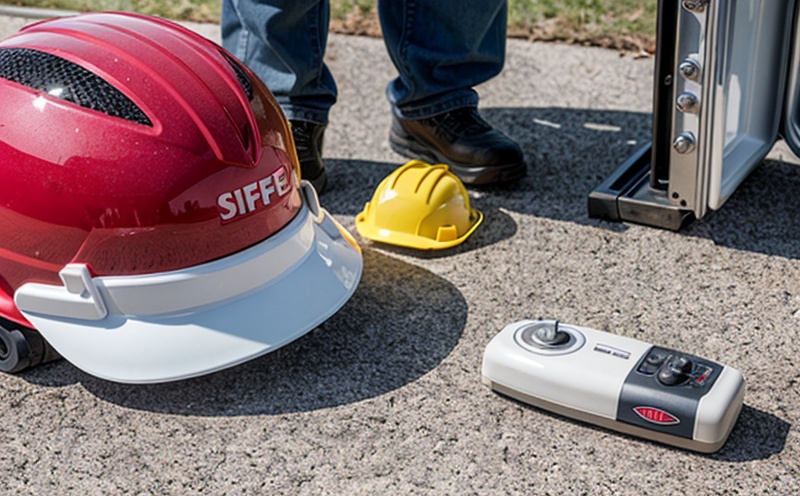ISO 18832 Thermal Protective Aid Testing
The ISO 18832:2009 standard specifies requirements and test methods for thermal protective aids (TPAs) used in maritime safety equipment. TPAs are designed to provide protection against heat fluxes from a fire source, ensuring the survival of crew members by preventing severe burns or death.
These devices are critical components of life-saving appliances such as immersion suits and rescue boats. Compliance with ISO 18832 is essential for manufacturers aiming to ensure their products meet global maritime safety standards set forth by organizations like the International Maritime Organization (IMO).
The testing process involves simulating a fire scenario where the TPA is subjected to high temperatures, radiant heat, and convective heat. The primary goal is to determine whether the TPA can maintain its protective integrity under these conditions without compromising on functionality or usability.
Real-world applications of this test are numerous. For instance, when a fire breaks out at sea, the time it takes for a crew member wearing an immersion suit with integrated TPAs to reach safety could be critical. If the TPA fails during such emergencies, it could lead to severe injuries or fatalities.
Understanding the specific parameters involved in testing helps in appreciating why compliance is so important:
- Temperature Exposure: TPAs are exposed to temperatures up to 250°C for a specified duration, simulating real-life fire scenarios.
- Heat Flux Density: The heat flux density used during testing ranges from 1.8 MW/m² to 7.6 MW/m² depending on the TPA’s intended use and performance criteria.
- Mechanical Stress: Simulated physical stress tests are conducted to ensure that TPAs remain functional even after exposure to extreme temperatures.
Proper specimen preparation is crucial before conducting these tests. This includes ensuring that the TPA conforms to all dimensional and manufacturing specifications outlined in ISO 18832. Any deviation from these guidelines can lead to inaccurate test results, which might not reflect true product performance.
The testing apparatus typically consists of specialized chambers capable of generating controlled environments necessary for simulating fire exposure conditions. These chambers are equipped with sensors and control systems that monitor temperature, heat flux density, and other relevant parameters throughout the test duration.
Benefits
- Enhanced Safety: Compliance ensures that TPAs meet stringent safety standards, thus enhancing crew protection in emergencies.
- Global Acceptance: Certification to ISO 18832 guarantees compatibility with international maritime regulations and facilitates export of life-saving equipment to different countries.
- Improved Reputation: Demonstrated adherence to global standards can significantly enhance a manufacturer’s reputation among customers, stakeholders, and regulatory bodies.
- Reduced Liability Risks: By ensuring that TPAs perform as expected under adverse conditions, manufacturers reduce potential liability for accidents or injuries resulting from equipment failure.
Why Choose This Test
The ISO 18832 Thermal Protective Aid Testing is vital because it ensures that life-saving appliances comply with internationally recognized standards, thereby enhancing maritime safety. For quality managers and compliance officers, this test provides assurance that the TPAs they produce meet rigorous performance criteria.
R&D engineers benefit from this testing as it helps them refine product designs to better withstand extreme environmental conditions while maintaining optimal functionality. Procurement teams can also leverage these results when selecting suppliers who demonstrate commitment to high-quality safety equipment.
By investing in ISO 18832 compliant TPAs, organizations contribute positively towards improving overall maritime safety standards and contributing to safer working environments for seafarers worldwide.
Competitive Advantage and Market Impact
Compliance with ISO 18832 not only ensures product quality but also offers significant competitive advantages. It allows manufacturers to enter new markets where stringent safety regulations are in place without having to undergo additional certification processes.
In today’s globalized market, meeting international standards is often a prerequisite for doing business across borders. By offering products certified under ISO 18832, companies can differentiate themselves from competitors and attract more clients who prioritize safety and reliability.
Moreover, compliance with these standards fosters trust among end-users and stakeholders, which translates into long-term relationships and increased market share. This is particularly important in the maritime industry where reputation plays a crucial role in maintaining customer loyalty.





